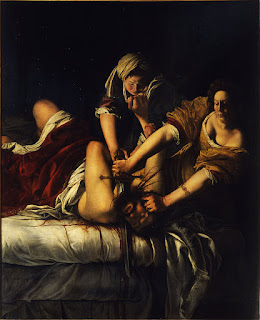Portraits were considered unique in the history of art
 |
| Giuseppe Arcimboldo's portrait, in fruit and vegetables, of Holy Roman Emperor Rudolph II |
Unique at the time, Arcimboldo’s work was greatly admired in the 20th century by artists such as Salvador Dali and his fellow Surrealist painters.
Giuseppe’s father, Biagio Arcimboldo, was also an artist and Giuseppe followed in his footsteps designing stained glass and frescoes for churches.
Arcimboldo (sometimes also known as Arcimboldi) at first painted entirely in the style of the time. His beautiful fresco of the Tree of Jesse can still be seen in the Duomo of Monza.
But in 1562 he abruptly changed his style after moving to Prague to become court painter to the erudite King Rudolph II.
 |
| Giuseppe Arcimboldo's self-portrait, now in the National Gallery in Prague |
Arcimboldo also painted settings for the court theatre in Prague and he became an expert in illusionist trickery. His paintings contained allegorical meanings, puns and jokes that were appreciated by his contemporaries, but were lost upon later audiences.
His eccentric vision is epitomised in his portraits of Summer and Winter in the Kunsthistorisches Museum in Vienna.
In his painting of The Librarian, painted in about 1566, he was criticising wealthy people who collected books just to own them rather than to read them.
By using everyday objects such as the curtains that created individual study rooms in a library and the animal tails that were used as dusters, it was both a portrait and a still life painting at the same time. It is now in a museum in Stockholm.
Given the Renaissance fascination with puzzles, riddles and the bizarre, it is thought Arcimboldo was catering to the tastes of his time.
 |
| Arcimboldo's 1566 painting, The Librarian |
The artist came back to live in Milan after retiring from working at the royal court and leaving Prague. He died in his home city in 1593.
It was not until 1885 that an art critic published a monograph on Arcimboldo’s role as a portrait painter.
With the arrival of surrealism in the 20th century, many articles and books were published referring to his work.
Arcimboldo-style fruit people have appeared in books, films and video games subsequently. There is a series of audiobooks with a portrait of William Shakespeare made out of books, similar to Arcimboldo’s Librarian, being used as the logo for the front cover.
 |
| Arcimboldo designed stained glass windows for the Milan Duomo |
Milan, where Giuseppe Arcimboldo was born and died, is the capital city of Lombardy. Arcimboldo worked on the Duomo with his father when he was a young man, designing pictures for the stained glass windows, including the one depicting Santa Caterina d’Alessandria. Construction of the Duomo, in Piazza Duomo in the centre of Milan, began in 1386, but the building took almost six centuries to complete. It is the largest church in Italy and the third largest church in the world.
| The Pinacoteca Tosio Martinengo in Brescia |
Giuseppe Arcimboldo’s painting of Spring, painted in 1580, can be seen in the collection of the Pinacoteca Tosio Martinengo in Brescia in Lombardy. The gallery in Piazza Moretto in the centre of the town has paintings by many other artists from the region, dating from the 13th to the 18th centuries.
More reading:
Giorgio de Chirico, Surrealist artist who founded the scuola metafisica
Simonetta Vespucci, the Renaissance beauty every artist wanted to paint
The Futurist art of Luigi Russolo
Also on this day:
1934: The death of fashion designer Giorgio Armani
1576: The death by strangulation of Medici wife Eleonora di Garzia di Toledo
Home



